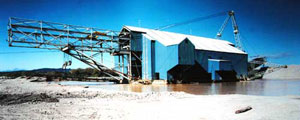Dredge Operator
Tasks & duties

Depending on the type of dredge they operate, dredge operators may do some or all of the following:
-
study instructions and diagrams
-
start the motor and pump water to clear the machinery's pipeline
-
position and monitor barges
-
lower the equipment into the area to be dredged
-
pump or scoop out silt or debris
-
deposit the silt or debris onshore, at sea, or in settlement ponds
-
maintain machinery and equipment in good working order
-
operate Global Positioning Systems (GPS), depth-finders, and radar and radio equipment
-
check tide charts
-
may operate computerised tracking systems, to monitor where the dredge is pumping or scooping material from
Specialisations
Pothole Dredge Operator
Pothole dredges have a large sluice pump that is lowered onto the seabed. The sluice pump sucks up the surrounding sand, sediment and material, and deposits it into a barge. The sluice pump is then raised and moved a few metres to repeat the same process. Pothole dredges usually work from a barge and are stationary. Dredge operators on this type of dredge do not need seagoing qualifications.
Grab Dredge Operator
Grab dredges work like cranes. They have a bucket on the end of a boom, which is lowered onto the seabed. The bucket opens and closes grabbing into the sediment and filling the bucket. The boom is then raised from the seabed and directed over a barge. The bucket then opens, releasing the sediment onto the barge.Grab dredges usually work from a barge and are stationary. Dredge operators on this type of dredge do not need seagoing qualifications.
Back-Hoe Dredge Operator
Back-hoe dredges are diggers that can be permanently attached to a barge, or driven on to a barge for specific dredging. The barges usually have hydraulic spuds that are used to position the barge and keep it stable. These spuds extend through the barge and into the sediment of the seabed to keep the barge stationary.As barges are non-motorised and towed by tugs, dredge operators on this type of dredge do not need seagoing qualifications.This type of dredge is also referred to as a dipper dredge.
Cutter Suction Dredge Operator
Cutter suction dredges have rotating cutters that spin on the end of a boom. These rotating cutters are lowered underwater to the seabed and cut out sections of sediment and material. The loose sections that have been cut away are then sucked up through a trailing suction pump and deposited into a barge for disposal.Cutter suction dredges can be attached to barges or seagoing vessels. If the dredge is attached to a seagoing vessel the dredge operator needs seagoing qualifications.
Trailing Suction Dredge Operator
Trailing suction dredges are vessels that trail large suction dredges behind them. This suction dredge sucks up sediment and material that is pumped onboard or onto a barge for disposal.Trailing suction dredges are motorised vessels and dredge operators need seagoing qualifications. This type of dredge is operated by two people, a ticketed skipper who drives the vessel and a pump-man who operates the trailing suction dredge.
Skills & knowledge

Dredge operators need to have:
-
skill operating dredging vessels or any associated dredging equipment such as diggers, cranes or suction pumps
-
skill operating small vessels such as barges or tugs
-
knowledge of the area they are dredging
-
good computer skills to use GPS equipment, depth finders, and survey charts
-
the ability to interpret diagrams, drawings and plans
-
mechanical or engineering skills for maintenance purposes
-
knowledge of maritime rules and safety procedures
-
the ability to follow instructions
Entry requirements
To become a dredge operator previous ship-handling experience is required, and depending on the size of the vessel, you may also need to have a Coastal Master's Ticket.
Dredge deckhands may need to have a Commercial Launchmaster Ticket, as they often relieve the skipper and steer the dredge.
Further information regarding seagoing qualifications is available from the Maritime Safety Authority.
Dredge operators who operate diggers or cranes from a barge need to be experienced in operating these machines. A Heavy Trade licence (classes 2 to 5, depending on the vehicle) with T, W, R (tracks, wheels, rollers) endorsements is needed to operate earthmoving machinery.
Further information on driver licensing is available from the Land Transport Safety Authority.
Secondary education
At least three years of secondary school education is preferred by most employers. Sixth Form Certificate or NCEA equivalent English and maths is needed to operate a seagoing dredging vehicle.
Training on the job
Skills are gained on the job.
Useful experience
Useful experience for dredge operators includes:
-
work as a tug master or deck officer
-
work as an earthmoving machine operator or operating other machinery
-
work as a mechanic or maintenance and diagnostics engineer
-
work as a deckhand, oil rigger or pipe-layer
-
engineering work
Related courses
Plant and Machine Operations
For more information, please refer to Career Services.
Document Actions
